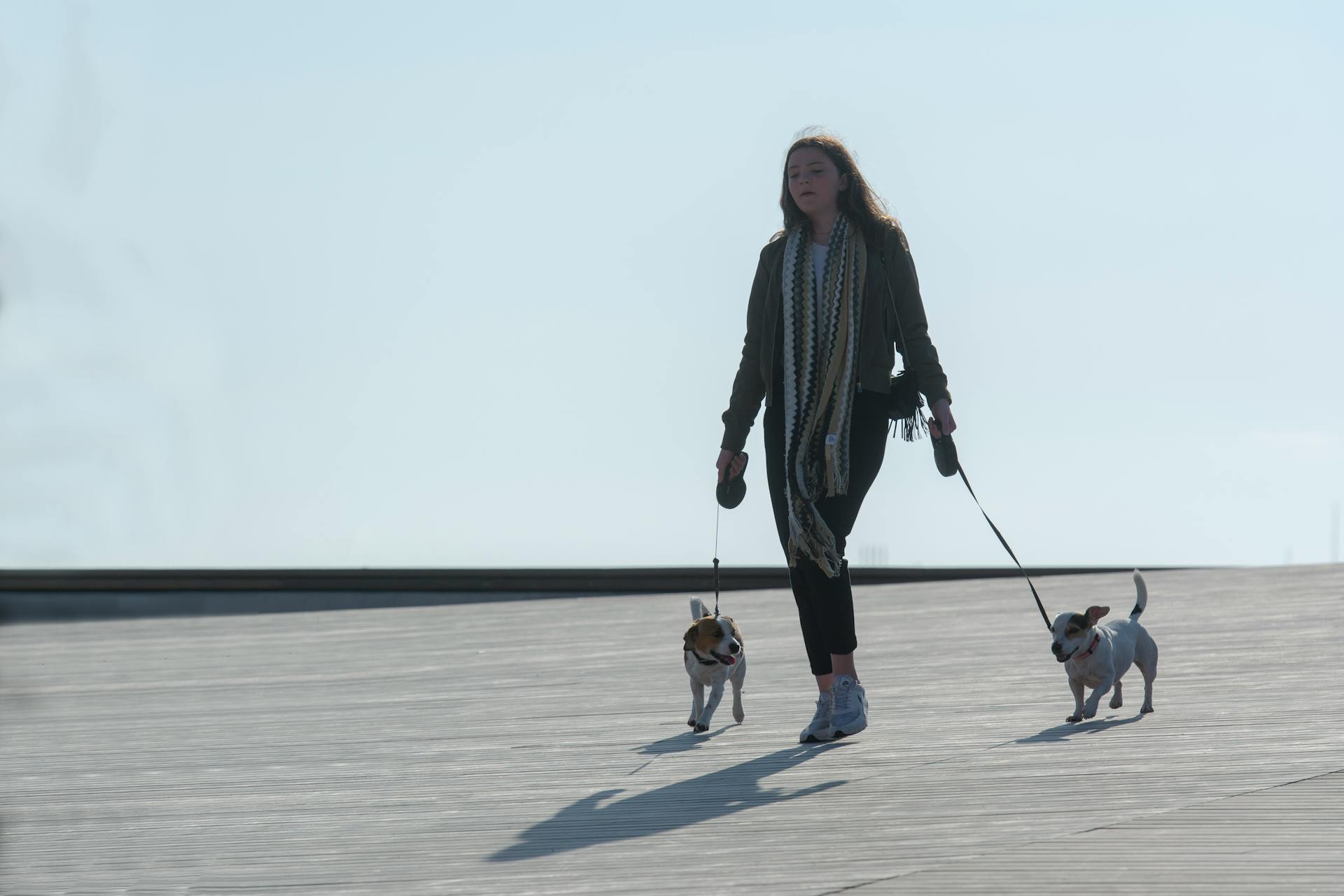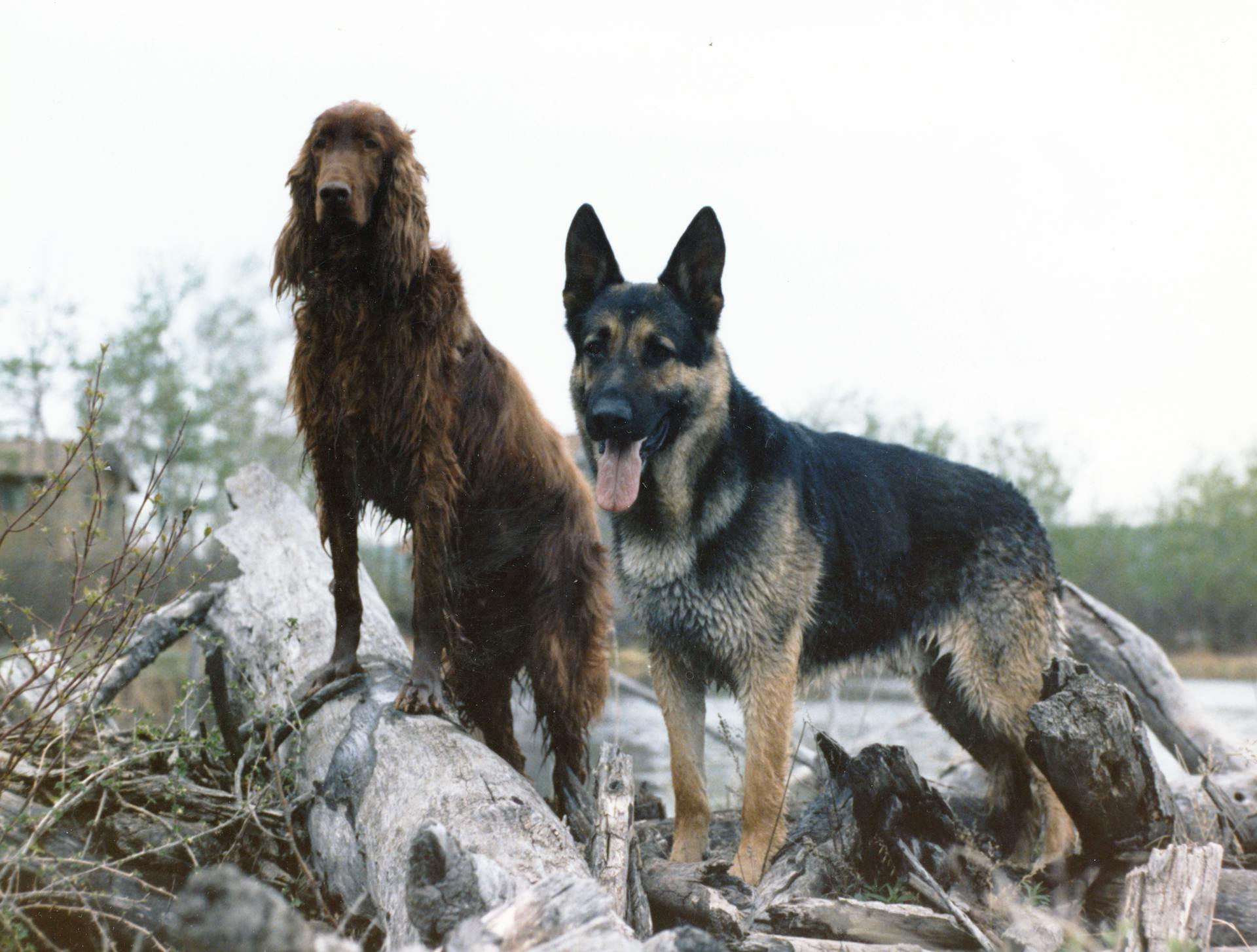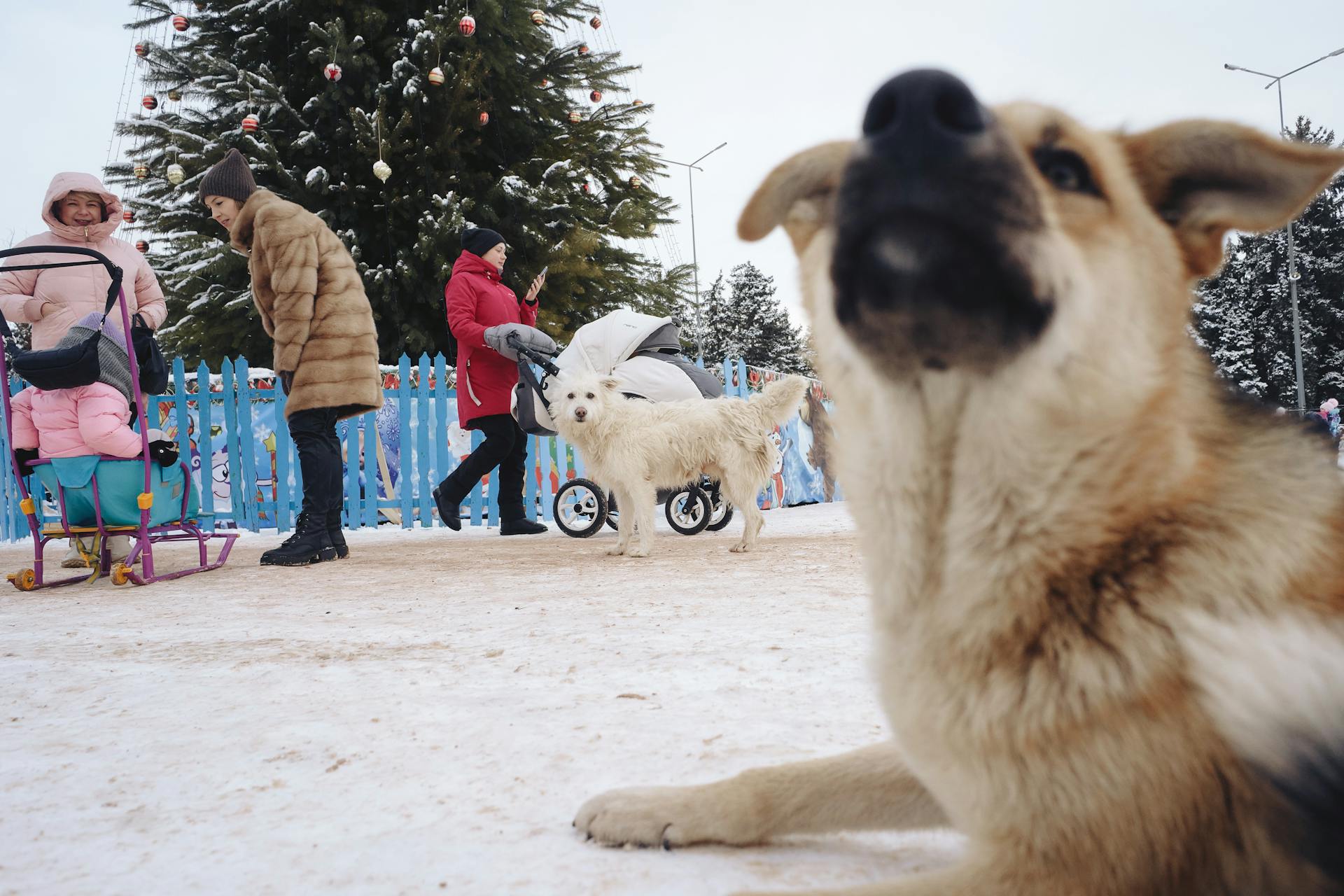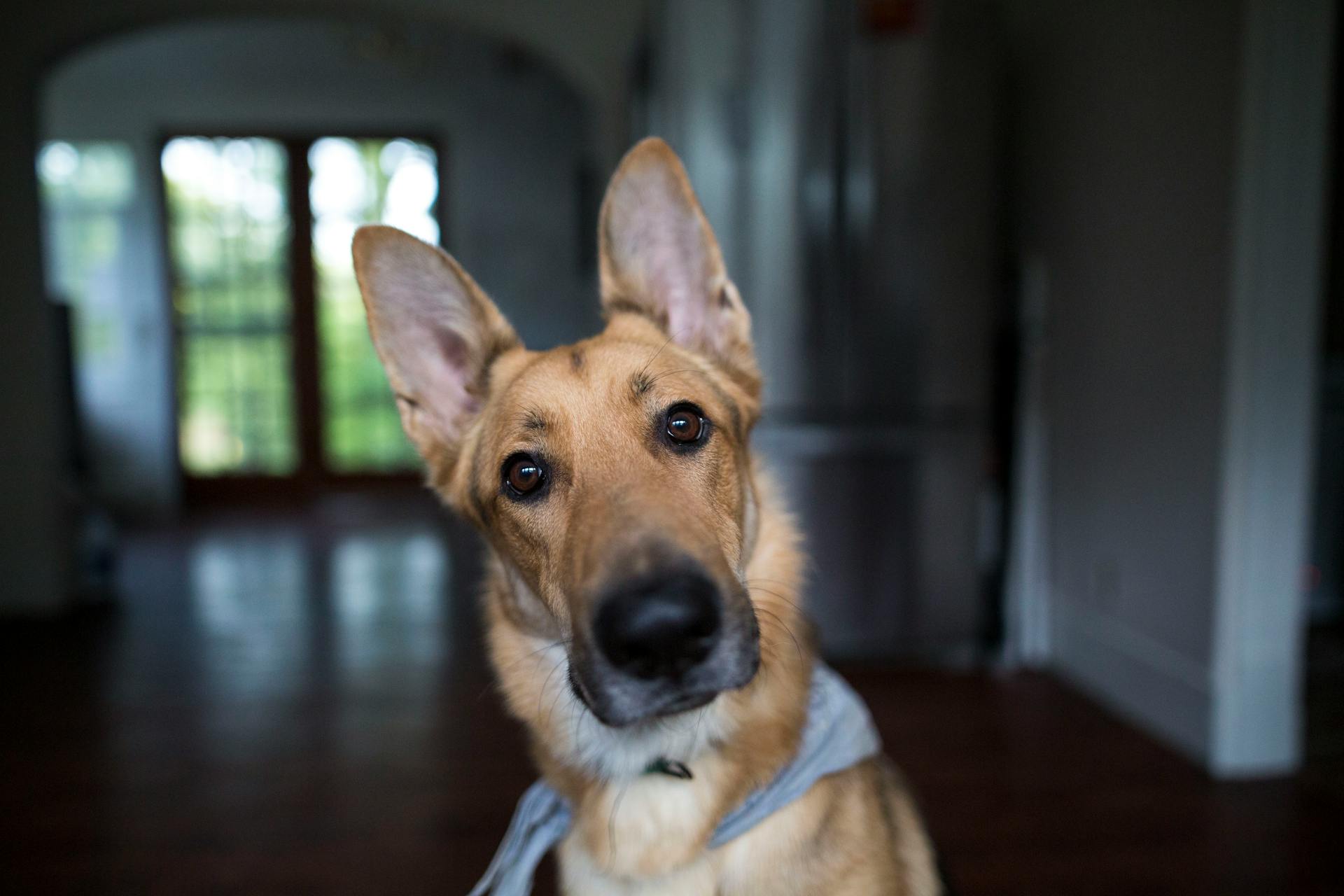
If your dog has been exposed to poison ivy, it's essential to know the symptoms. Dogs can get poison ivy, but the reaction is different from humans.
The urushiol oil in poison ivy causes an allergic reaction in dogs, leading to skin irritation and inflammation. This oil can remain active for up to five years.
To prevent your dog from getting poison ivy, keep them away from areas where poison ivy is growing. Wear protective clothing and gloves when walking your dog in wooded areas.
Discover more: Poison Ivy
Symptoms and Diagnosis
Symptoms of poison ivy in dogs can appear within a week of exposure and include increased itching and scratching, increased licking, red blister-like raised bumps on the skin, inflamed skin, and open sores.
The rash caused by poison ivy sap can resemble other rashes and dermatitis, making it essential to check for symptoms regularly, especially where the hair is thin or short.
Dogs can develop a severe reaction if they ingest the plant, and symptoms may include vomiting, diarrhea, and anaphylactic shock.
Here are some common symptoms of poison ivy in dogs:
- Red skin
- Swelling and itching
- Fluid-filled blisters or scabs
- Vomiting (ingestion)
- Diarrhea (ingestion)
A veterinarian can diagnose poison ivy poisoning based on symptoms and a history of exposure, and may recommend topical treatments or oral anti-inflammatory or antihistamine medications to ease discomfort.
What Causes the Reaction?
The urushiol oil in poison ivy is the culprit behind those nasty reactions. This oil is found in the plant itself and can easily transfer to other objects, making it possible to get infected through indirect contact.
You don't have to touch poison ivy directly to get a reaction. If the oil gets on your tools, clothing, or even your dog's coat, it can cause a reaction.
Inhaling the smoke from burning poison ivy is particularly hazardous, as it can lead to a very severe reaction that might even require a hospital visit.
On a similar theme: How to Get Rid of Poison Ivy on a Dog
What Does It Look Like?
Poison ivy can appear as a plant, a vine, or even a shrub or small tree. It's not just a single form, so be prepared to recognize it in different guises.
Poison ivy has three leaves, a key identifying feature. These leaves are a crucial clue to its presence.
The stems of poison ivy alternate to the left and then the right, a pattern known as alternate branching. This is different from other plants that have leaves arranged side by side.
Poison ivy doesn't have thorns, so that's one way to rule out other possibilities.
Symptoms

Symptoms of a poison ivy reaction in dogs can take up to a week to develop, but they're unmistakable once they appear.
The symptoms are similar to those experienced by humans, including increased itching and scratching, red, blister-like raised bumps on the skin, inflamed skin, and open sores.
One of the most common symptoms is increased licking, which can be a sign that your dog is trying to soothe the itchy skin.
Dogs can also develop a severe reaction if they ingest the plant, which can cause vomiting and diarrhea.
If your dog comes into contact with poison ivy, you should check for symptoms regularly, especially in areas where the hair is thin or short, such as the nose, muzzle, belly, groin, and inside of the legs.
Here are some common symptoms of a poison ivy reaction in dogs:
- Red skin
- Swelling and itching
- Fluid-filled blisters or scabs
- Vomiting (ingestion)
- Diarrhea (ingestion)
In severe cases, the symptoms can include skin inflammation and swelling, itching and scratching, and the development of open sores with time.
If you suspect that your dog has ingested poison ivy, it's essential to take them to the vet immediately, as this can cause anaphylactic shock.
In less severe cases, the symptoms can be managed with topical treatments, oral anti-inflammatory or antihistamine medications, and soothing oatmeal baths.
Prevention and Treatment
Preventing poison ivy exposure is key to keeping your furry friend safe. Limit your dog's exposure to poison ivy by keeping them on a leash when walking in wooded areas and not leaving them unattended in your yard if you have poison ivy present.
If you're not familiar with identifying poisonous plants, stick to sidewalks and streets in your neighborhood for your daily walk. You can also use protective gear like Walkee Paws, doggie leggings that protect your dog's paws and legs from poison ivy sap.
To prevent your dog from getting poison ivy, know what poison ivy looks like, keep an eye on your dog when walking near bushes and grass, don't let your dog wander outdoors alone, and keep them on a leash on walks.
Here are some additional tips to help prevent poison ivy exposure:
- Recognize poison ivy by its leaves, which typically have three shiny green leaves with a reddish tint.
- Be aware of your surroundings when hiking or walking in areas where poison ivy may be present.
- Keep your dog's paws clean and dry to prevent poison ivy sap from sticking to them.
If your dog does get poison ivy, a warm, soapy bath is the first step in treatment. Your vet may also recommend over-the-counter antihistamines like Benadryl to ease your dog's allergic reaction and keep them calm.
Tips for Preventing

Prevention is always the best course of action when it comes to your furry friend's safety. Limiting their exposure to poison ivy is key, so keep them on a leash when walking in wooded areas and avoid letting them wander outdoors alone.
If you have poison ivy in your yard, don't leave your dog unattended. It's also essential to know what poison ivy looks like to recognize it, so take some time to learn about the plant's identification.
To help prevent an incident with poison ivy, keep an eye on your dog when walking near bushes and grass. You can also use doggie leggings like Walkee Paws to protect their paws from coming into contact with the sap.
Here are some essential tips to prevent poison ivy exposure:
- Know what poison ivy looks like to recognize it.
- Keep an eye on your dog when walking near bushes and grass.
- Don't let your dog wander outdoors alone.
- Keep your dog on a leash on walks.
Treating
Treating poison ivy in dogs requires prompt action to prevent further irritation and potential infection. If your dog comes into contact with poison ivy, dry wipe them as quickly as possible to prevent the toxic oils from reaching their skin.

Wearing gloves while wiping down your dog and avoiding petting them will help prevent you from getting a poison ivy reaction as well. If your dog begins itching, bathe them in an oatmeal shampoo to help soothe their skin.
A warm, soapy bath is the first step in treating a poison ivy rash on your dog. With your vet's recommendation, you may be able to give your dog an over-the-counter antihistamine, such as Benadryl, to ease their allergic reaction and keep them calm.
If your dog has ingested the plant or its sap, immediate action is required. A vet visit is necessary if your dog has symptoms such as fever, upset stomach, and loss of appetite after being near poison ivy.
Here are some general steps to follow when treating your dog for poison ivy:
- Bathe your dog in warm water using a mild shampoo and rinse thoroughly to remove as much of the plant's oil as possible.
- Use an oatmeal shampoo to help soothe your dog's skin if they begin itching.
- Wear gloves while bathing your dog and washing any towels used to dry them.
- Consider using a poison ivy cleansing treatment, such as Tecnu, or an anti-seborrheic or keratolytic shampoo to minimize exposure.
Your vet may prescribe topical ointments to reduce itching and make your dog more comfortable. In severe cases, they may prescribe medication to treat symptoms and prevent infection.
Veterinary Advice and Care
If your dog gets a poison ivy rash, a warm, soapy bath is your first step, with your vet's recommendation.
Your vet may prescribe an over-the-counter antihistamine, such as Benadryl, to ease your dog's allergic reaction and keep them calm.
If your dog ingests the plant or its sap, immediate action is required, and a vet visit is in order if they have symptoms like fever, upset stomach, and loss of appetite.
Your vet will treat your dog with medications and possibly IV fluids to prevent dehydration.
The poison ivy rash on dogs isn't usually deadly, but it won't be fun for anyone involved.
Recommended read: Vet Prescription
Veterinary Advice
If your dog gets a poison ivy or oak rash, a warm, soapy bath is your first step. This can help remove some of the plant's oil from your dog's coat.
The visible symptoms of a poison ivy rash on dogs include a red rash and raised bumps, and your dog will likely scratch excessively. They may even bite their skin in an attempt to relieve the itching.
If you suspect your dog has ingested the plant or its sap, immediate action is required. A vet visit is in order if your dog has symptoms such as fever, upset stomach, and loss of appetite after being near poison ivy.
Your vet will treat your dog with medications and possibly IV fluids to prevent dehydration. They will be able to provide the best course of treatment for your dog's specific situation.
To prevent your dog from getting poison ivy, it's essential to know what the plant looks like. You can also take steps such as keeping an eye on your dog when walking near bushes and grass, and keeping them on a leash on walks.
Here are some additional tips to prevent poison ivy sap from getting on your dog's paws:
- Use doggie leggings like Walkee Paws that protect not only their paws but all the way up their legs too.
- Keep your dog from wandering outdoors alone.
Remember, prevention and early treatment are key to ridding your dog of poison ivy. By taking these steps, you can help keep your furry friend safe and comfortable.
Escaping a Stuck Dog
Escaping a Stuck Dog can be a stressful situation for both you and your furry friend. If your dog gets stuck in a tight spot, remain calm and assess the situation carefully.
The first thing to do is to try and reassure your dog that everything will be okay. If your dog is stuck in a hole or a narrow space, gently try to coax them out by speaking calmly and offering treats.
If your dog has gotten their fur contaminated with poison ivy, address the exposure as soon as you can. Put on rubber gloves and wash your dog as soon as possible after known exposure.
Use a shampoo such as Tecnu, an anti-seborrheic or keratolytic shampoo to minimize exposure. These shampoos are most effective when used immediately, so it's a good idea to carry them with you when hiking, camping, or spending time in areas that might have poison ivy.
See what others are reading: How Young Can a Female Dog Get Pregnant
Frequently Asked Questions
Can humans get poison ivy from dogs?
No, humans can get poison ivy from dogs if the dogs have come into contact with the urushiol oil found in poison ivy, oak, or sumac. If your dog has been exposed, it can transfer the oil to you through contact with their fur or skin.
What if my dog licks my poison ivy?
If your dog licks poison ivy, take them to a vet immediately, as symptoms can include vomiting and diarrhea. A vet can provide guidance on treatment to ease discomfort.
How long does poison ivy stay on dogs' fur?
Urushiol oil, the cause of poison ivy reactions, can remain active on a dog's fur for several days to weeks. This prolonged presence increases the risk of transferring the oil to other surfaces and people.
How do you treat poison oak rash on dogs?
To treat poison oak rash on dogs, consult a veterinarian for proper medication, as over-the-counter remedies can worsen the rash or cause an allergic reaction. Hydrocortisone and antihistamines like Benadryl may provide temporary relief, but under veterinary guidance.
Sources
- https://www.puppyleaks.com/poison-ivy/
- https://walkeepaws.com/blogs/news/can-dogs-get-poison-ivy-how-to-treat-poison-ivy-on-dogs
- https://wagwalking.com/condition/poison-ivy-poisoning
- https://peacefulpawspetcare.com/2018/04/01/what-happens-if-my-dog-comes-in-contact-with-poison-ivy/
- https://www.petmd.com/dog/general-health/can-dogs-get-poison-ivy
Featured Images: pexels.com


